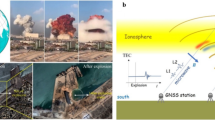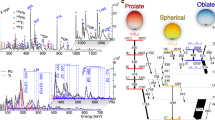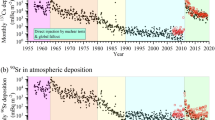Abstract
FOLLOWING the US and USSR atmospheric test series in 1954–1962, numerous microbarograph records1–8 of air waves generated by nuclear bomb tests were published. Previous theoretical interpretations7,9 of such waveforms have required some explicit knowledge of the average atmospheric temperature and wind profiles above the path connecting source to microbarograph. Such profiles are never sufficiently well known and vary from point to point, and as seemingly small changes in the profiles cause relatively large changes in the waveforms, it would seem to be difficult to estimate the explosion energy yield to even order of magnitude accuracy from such records. Recently, however, in a further account of this work to be published elsewhere, we have succeeded in deriving an approximate theoretical relationship between certain waveform features and energy yield which is insensitive to changes in atmospheric structure. This relationship is given by  where E is energy release, pFPT is the first peak to trough pressure amplitude (see Fig. 1), re is radius of the Earth, r is the great circle distance from burst point to observation point, Hs is a lower atmosphere scale height, c is a representative sound speed, and T1,2 is the time interval between first and second peaks. The purpose of the present communication is to describe the extent to which the above relation agrees with the existing available data.
where E is energy release, pFPT is the first peak to trough pressure amplitude (see Fig. 1), re is radius of the Earth, r is the great circle distance from burst point to observation point, Hs is a lower atmosphere scale height, c is a representative sound speed, and T1,2 is the time interval between first and second peaks. The purpose of the present communication is to describe the extent to which the above relation agrees with the existing available data.
This is a preview of subscription content, access via your institution
Access options
Subscribe to this journal
Receive 51 print issues and online access
199,00 € per year
only 3,90 € per issue
Buy this article
- Purchase on SpringerLink
- Instant access to full article PDF
Prices may be subject to local taxes which are calculated during checkout
Similar content being viewed by others
References
Yamamoto, R., Bull. Amer. Meteorol. Soc., 37, 406 (1956).
Araskog, R., Ericsson, U., and Wagner, H., Nature, 193, 970 (1962).
Carpenter, E. G., Harwood, G., and Whiteside, T., Nature, 192, 857 (1961).
Farkas, E., Nature, 193, 765 (1962).
Jones, R., Nature, 193, 229 (1962).
Wexler, H., and Hass, W. A., J. Geophys. Res., 67, 3875 (1962).
Harkrider, D. G., J. Geophys. Res., 69, 5295 (1964).
Donn, W., and Shaw, D., Rev. Geophys., 5, 53 (1967).
MacKinnon, R., Quart. J. Roy. Meteorol. Soc., 93, 436 (1967).
Båth, M., A 4270–4271 (Seismological Institute, Univ. Uppsala, 1962).
Author information
Authors and Affiliations
Rights and permissions
About this article
Cite this article
POSEY, J., PIERCE, A. Estimation of Nuclear Explosion Energies from Microbarograph Records. Nature 232, 253 (1971). https://doi.org/10.1038/232253a0
Received:
Issue Date:
DOI: https://doi.org/10.1038/232253a0
This article is cited by
-
Surface-to-space atmospheric waves from Hunga Tonga–Hunga Ha’apai eruption
Nature (2022)
-
Acoustic-Gravity Lamb Waves from the Eruption of the Hunga-Tonga-Hunga-Hapai Volcano, Its Energy Release and Impact on Aerosol Concentrations and Tsunami
Pure and Applied Geophysics (2022)
-
A Barometric Survey of Dust-Devil Vortices on a Desert Playa
Boundary-Layer Meteorology (2014)
-
A climatology of infrasound detections in northern Norway at the experimental ARCI array
Journal of Seismology (2011)
-
Mechanism of longwave acoustic perturbation generation in the atmosphere by a floating cloud of explosion products
Combustion, Explosion, and Shock Waves (1987)



